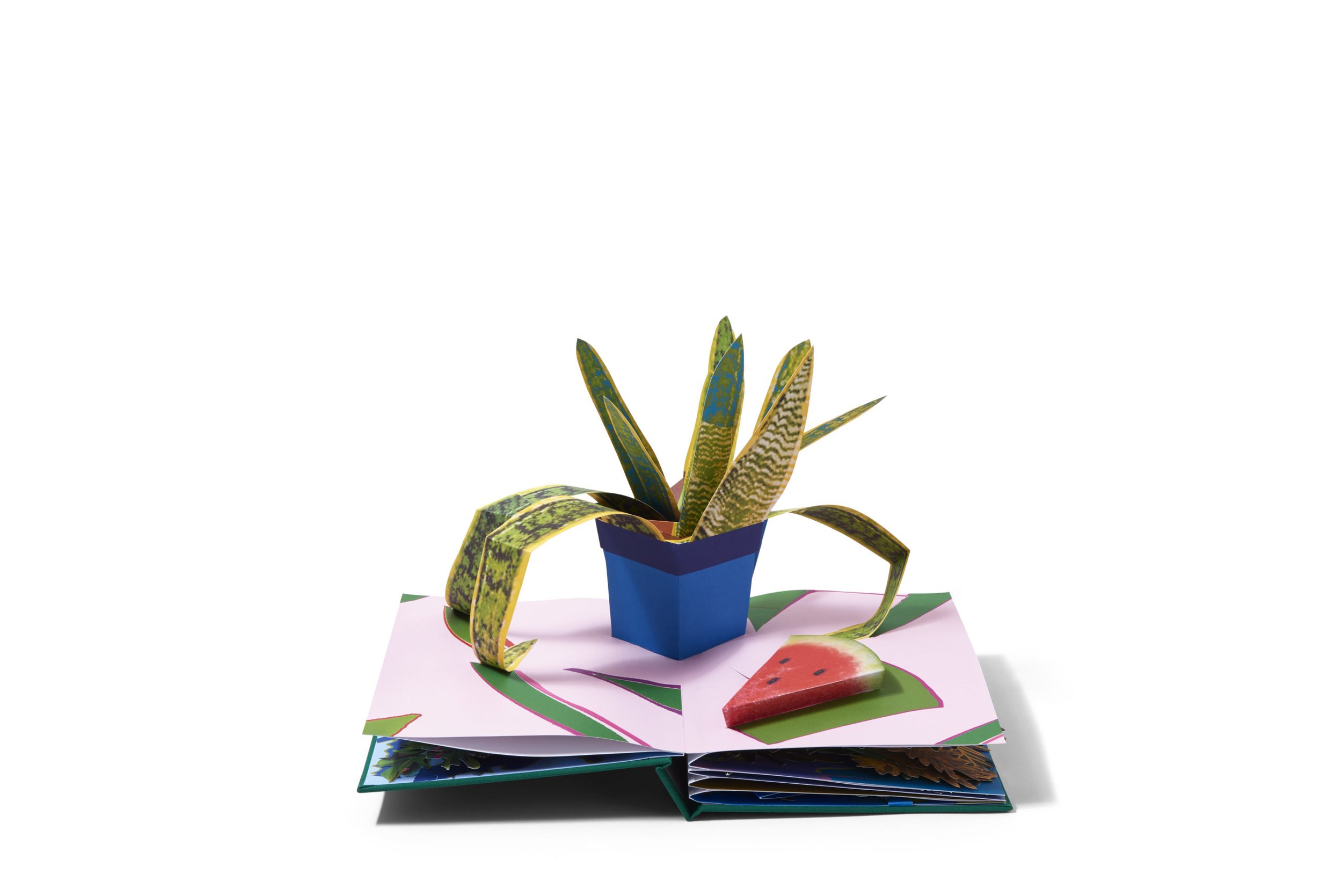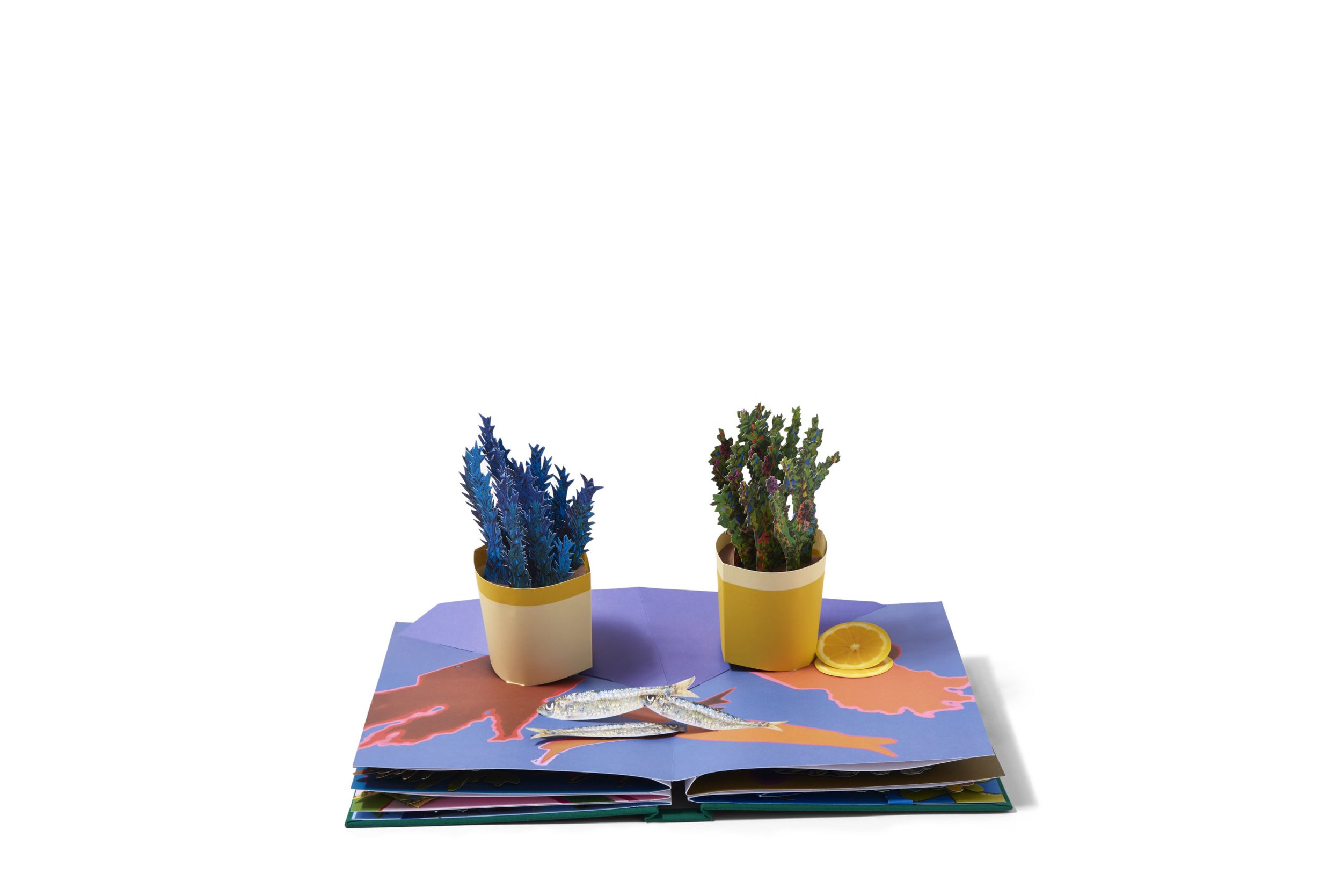On Daniel Gordon’s Houseplants
Book Art Review
Spring 2023, issue 2
Daniel Gordon, Houseplants (New York: Aperture, 2020). Popups by Simon Arizpe.
Upon hearing the phrase “pop-up book,” I suspect many would imagine elaborate children’s books featuring animated nursery rhymes, underwater worlds revealed in three-dimensions, or castles springing skyward. The thoughtful ways contemporary artists use this dynamic form are unlikely to be top of mind. And yet, there is a history of compelling pop-up books functioning as art objects, from Andy Warhol’s Index (Book) (1967) to Kara Walker’s Freedom, a Fable (1997) and Tomás Saraceno’s From Arachnophobia to Arachnophilia (2022), to name a few. Add to this list Houseplants (2020), a collaboration between photographer Daniel Gordon and paper engineer Simon Arizpe, edited by Denise Wolff at Aperture.
Gordon is best known for making photographs of his constructed still-life tableaux, lushly patterned, vibrantly colored scenes populated with three-dimensional objects formed from cut, taped, and glued images printed from the Internet; he revels in the camera’s unique ability to transform what appears in front of his lens into a new reality. Parallels are inevitably drawn between these photographs and the mediums of collage, painting, and sculpture. Gordon leverages this disorientation and tension to mesmerizing effect—even more so in recent years—blurring boundaries and expectations with projects such as Houseplants.
The kind of pop-ups used in Houseplants are not what makes it distinct from the thousands of other pop-up books lining bookshelves around the world. It is the rigorous conceptual underpinning and exploration that sparked the project in the first place that sets this book apart. Unlike traditional photobooks, Houseplants does not replicate Gordon’s existing photographs. It is instead an artwork in its own right, conceived specifically for the pop-up book medium.
Modestly scaled and, at first glance, more binder than book, Houseplants appears unassuming with a single tipped-in photo on the kelly-green linen cover. Upon opening the book, a blossoming crown-of-thorns unfurls, nearly one-and-a-half feet high, with a life-sized half pomegranate at the base of the potted plant; more compositionally straightforward than his elaborate, often large-scale photographs, the minimal scene befits the book’s more intimate context. Gordon digitally creates the backgrounds and shadows in his photographs—which are often brightly colored and sometimes quite intricate—printing them for integration into his three-dimensional tableaux. He streamlines his approach in Houseplants, translating simplified, wildly-hued shadows onto the book pages to approximate the jagged and rounded edges one might see were this still life surreally lit. This and the five spreads that follow were created and sequenced in order to provide visual diversity within the narrowly given subject matter—plants and foods—as well as variety in how the still life inhabits the book’s spread and is animated by the pop-up mechanism.
The three-dimensionality of Houseplants required thinking about the appearance of Gordon’s objects from every angle, considerations distinct from those involved in producing photographs. For his photographic compositions, the objects are made for the camera’s perspective; the crude, handcrafted constructions of crumpled paper, glue, and tape are revealed if one walks around them, spoiling the illusion of reality rendered in a print. The book, in effect, reverses his typical process; instead of rendering flat his sculptural tableau, here, Gordon invites the viewer to consider the depth, scale, and construction of his scene recast in three dimensions. Play and discovery characterize the inherent physical relationship to Houseplants as you inspect from the front, back, top, and sides; there is something to be seen from every angle. The various supports, flaps, and folds responsible for both the sculptural quality and movement of the objects are not disguised, openly acknowledging the engineering and construction otherwise concealed by the camera in Gordon’s photographs.
As much as this book is a celebration of Gordon’s unique process, it is equally a demonstration of Arizpe’s ability to artfully employ pop-up mechanics to dynamically bring these ideas to life. The scale, position, and movement of objects within a given spread—even the total number of spreads included—represent a delicate balancing act between Gordon’s vision and Arizpe’s engineering knowledge; the bending, sword-like leaves of the snake plant must attach in particular spots and the strawberry cannot be positioned just anywhere on the spread. The rigidity required of pop-ups dictates the thicker-than-average paper used. In contrast to the glossy pages of many pop-up books, the matte, uncoated paper used here serves both practical and aesthetic requirements. In Arizpe’s experience, the glued elements adhered better with matte stock, which, as luck would have it, also more faithfully communicates the surface of Gordon’s original sculptures.[1] The vivid colors achieved throughout are a testament to meticulous pre-press work as matte stock inevitably dulls colors. Houseplants blends the machine-made (offset printing) and handmade (assembled by hand), evocatively simulating Gordon’s practice in the book’s production.
Though a print run of 1,000 may sound considerable for a book involving many small die-cut pieces assembled by hand, of the few worldwide printers who can manufacture pop-up books, most require producing 10,000 copies or more. Thus, the relatively limited run, coupled with the extensive labor involved in engineering and craftsmanship—from concept to completion—is reflected in the book’s price tag. When you consider how Houseplants more closely resembles an artwork than monograph, $150 feels entirely reasonable.
While other artists often employ the pop-up book format for its resonance with project-specific ideas, Houseplants differs, instead representing an expansion of Gordon’s oeuvre; his artistic process compellingly dovetails with the pop-up book medium. This book offers a new vehicle for exploring and pushing the boundaries of his ever-evolving practice, conceptual concerns, and approach to materials. The pop-up book format provides viewers with a new lens through which to consider the kinds of questions Gordon’s work elicits— about image-making, appropriation, the ambiguity of “truth” in photography, and the blurry distinctions between mediums. Producing this book ultimately informed Gordon’s process for creating monumental, steel sculptures as part of the inaugural commission for the Rose Kennedy Greenway in Boston, evidence of how this book has already reverberated beyond its pages.
[1] Phone conversation between the author and Simon Arizpe, August 10, 2022.






